In 2019 and early 2020, I was disappointed by my search engine traffic.
After studying SEO methods by listening to podcasts and reading, I was able to rebrand and follow effective SEO methods that work today.
Before we begin, let’s examine my stats so we have a before and after view.
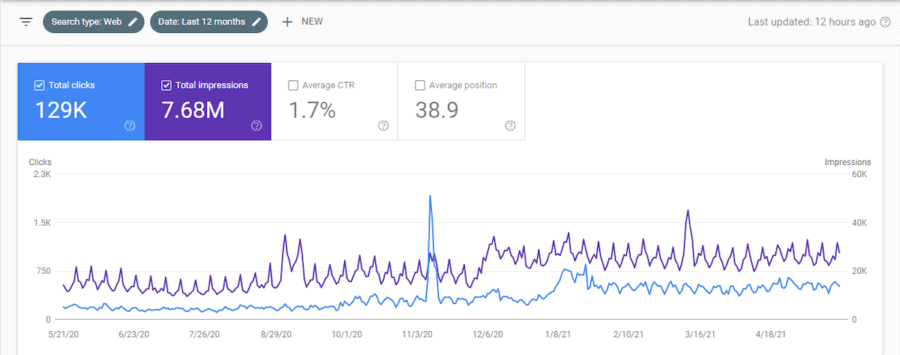
This Google Analytics screenshot shows two spikes, one in the Total Clicks in November. The other spike is in impressions in March.
These are favorable metrics. You want the impressions to be higher than the clicks. Impressions mean people see your website content. You want to see a spike in impressions so that a spike in clicks can follow. People can’t click your links if they don’t see them.
When you examine the screenshot, overall, you see both my traffic and metrics are continuing higher since November than before November.
Let’s discuss the SEO strategies that I feel caused the spikes in traffic and metrics.
When you are done reading this post, you will be able to follow these actionable methods to boost your own SEO. These strategies are free and provide you with a 3-part action plan.
Table of Contents
These are the SEO Methods That Work in 2021
Method 1: Update Your Content
Last November, there was a seasonal cause for my traffic spike: The U.S. Presidential Election occurred. Conservatives, furious at Facebook for taking down their content and shutting down their groups, flocked to the MeWe social media site.
Coincidentally, my site has MeWe reviews, and my traffic soared. However, when MeWe started gaining one million users a week, the biggest blogs in town, like Mashable, Rolling Stone, and Business Insider wrote about the site.
How can I compete against such giants? Simple! I regularly update the content.
Google likes fresh content. In my post, I make it clear that my information is current, and the post stays competitive in Google’s Search Engine Results pages. Today, the MeWe article is my 4th best-performing post which brings in 8% of my traffic. Considering the stiff competition, these results are impressive.
Method 2: Follow the E-A-T Criteria
Have you heard of Google’s E-A-T criteria?
E stands for Expert, A stands for Authority, and T stands for Trustworthiness. Only if you meet all three criteria will Google rank your posts high in the Search Engine Results Pages (SERPs).
If you link out to authorities and show you are an expert in your niche, Google will consider your web content trustworthy enough to show your posts to its users.
When I saw my traffic floundering, I analyzed why. I realized my guest posts were not ranking, but the posts I wrote were.
Considering Google’s E-A-T criteria, this makes sense. Google has no way of knowing if my guest authors are experts in my niche.
I always add content to my guest authors’ posts. Now, I mention myself as a co-author and I give my bio:
Janice Wald is the founder of MostlyBlogging.com. She is an ebook author, blogger, blogging coach, blogging judge, freelance writer, and speaker. She was nominated as the 2021 and 2019 Best Internet Marketer by the Infinity Blog Awards and in 2017 as the Most Informative Blogger by the London Bloggers Bash. She’s been featured on Small Business Trends, the Huffington Post, and Lifehack.
This makes it sound like I’m an authority in my niche, blogging.
Recently, my crazy text generator post ranked almost immediately after publication. The post explains to teachers as well as bloggers how to use unusual fonts to boost interest in text material.
I made sure to explain that in addition to being a blogger, I’m also a teacher so Google knows that I meet the “A” in E-A-T, and I am an authority. As a teacher, I know how to engage students.
YMYL
Here is another acronym that is important to understand in order to rank well.
Boosting your rankings in the Search Engine Results Pages (SERPs) is more complex than in the past and takes an understanding of various types of authority.
Gone are the days when you could stuff your keyword all over your post and assume it will rank. These outdated methods used to work, but Google is smarter now. Today, you need to focus on User Experience. Google wants to make sure the posts that get search engine visibility answers users’ queries and are written by authorities in the content niche.
For instance, you can write a post answering a medical question, but if you are not a doctor or medical expert, Google won’t rank your post on the first page of SERPs.
A client in the wellness niche came to me upset that her traffic tanked. I looked at her articles. She did not mention she is an expert in the wellness industry anywhere. On the contrary, she had blog posts about how to get healthy, yet she’s not a doctor.
Google doesn’t give her posts visibility since she doesn’t meet the E-A-T criteria.
Bloggers that write about YMYL topics (Your Money or Your Life) better be authorities in the medical and financial niches or suffer a loss of traffic.
Domain Authority Rank vs Moz Rank VS Moz Trust
In addition to being an expert in your content niche, to be an authority and meet the “A” in the E-A-T criteria for ranking, you need to make sure you optimize for these three metrics developed by Moz, a leader in SEO: Domain Authority Rank.
The Moz Domain Authority Rank is an indication of how well your blog posts will rank in the Search Engine Results Pages.
The Domain Authority Rank goes up to 100, the higher the number, the better the website.
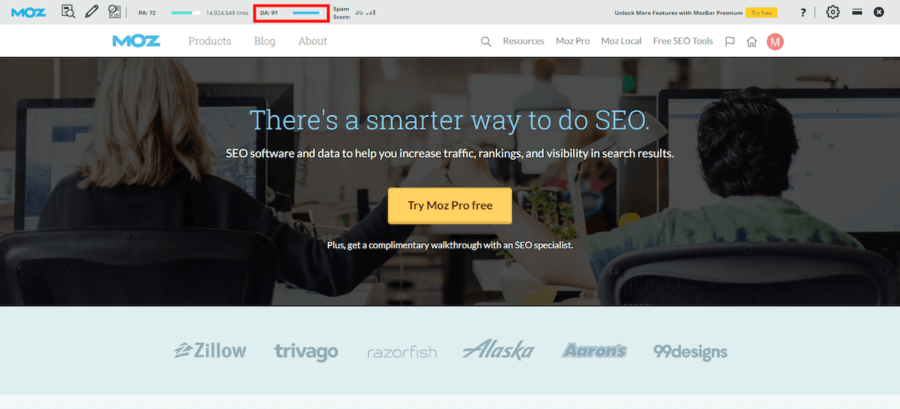
This screenshot was taken at Moz.com. Can you tell Moz has a Domain Authority Rank of 91? This is extremely high considering the rank goes up to 100. Therefore, Moz is considered an authority site.
Moz released three ways to boost this metric which is considered the SEO industry benchmark as to how to recognize a quality blog.
- Get links from authority websites.
In other words, get links from websites with high DAs (Domain Authority Rankings).
- Get links from unique websites.
Get links from new websites that have never linked to you before.
- Get links.
In other words, the more links you have pointing to your site, the better.
Moz Rank
In addition to the DA which reflects the quality of the blog, your individual blog posts are judged too. The metric is the Moz Rank.
The Moz Rank reflects the quality of your individual blog posts.
Moz Trust
As you can see, building links to your site is crucial if you are to be a successful search engine marketer.
However, are all links equal in the eyes of Moz?
No!
Moz Trust judges the merit of the links.
Do you want to know the best possible links you can build to your site?
The best links you can get are from .gov and .edu sites. If the link ends in .gov, the link is from a government institution, and if the link ends in .edu, the link is from a website that is an educational institution.
DoFollow vs NoFollow Links
Follow links carry more weight than no-follow links. Before 2019, no-follow links didn’t carry any weight with Google at all. In 2018, Google announced no-follow links would carry more weight than in the past but still not as much as follow links.
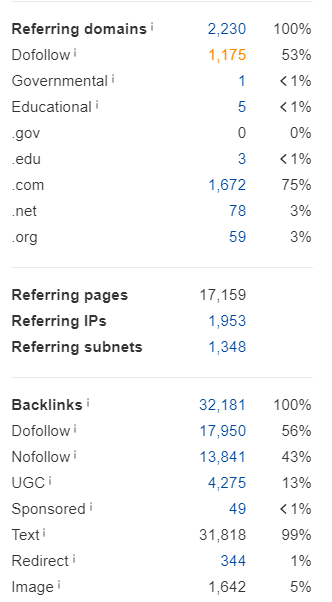
This Ahrefs screenshot shows a breakdown of my link portfolio.
As you can see, everything counts in determining whether your content will get favorable Google Rankings.
Method 3: Rebrand
I published a post about a Facebook dark post which was about Facebook ads. A contributing author sent the post to me and offered me compensation to publish the article. The problem: The post was too short. Google likes posts that answer all the searchers’ questions, not short posts that lack substance.
I didn’t know how to lengthen the post. My only experience using Facebook ads was negative; I lost money. Left without a choice, I detailed my negative experience attempting to purchase and profit from a Facebook ad.
The post generated traction. Interest among my readers was high. Two people even linked to the post to share with their own readers.
Then I realized that I don’t always have to share positive experiences to educate people on my blogs. They can be empowered with information about what NOT to do.
While looking for blog topics, I found the keyword: “how to get out of Facebook Jail.”
I’ve been thrown in Facebook Jail for spamming more times than I care to count. Finally realizing that sharing negative experiences can be educational, I rebranded and published How to Get Out of Facebook Jail, 3 Ways to Escape. Today, my post explaining how to get out of Facebook Jail is my best-performing post. 21% of my traffic goes to this article. The post ranks for 346 keywords and has 120 links from other websites.
Wrapping Up
In closing, following these SEO methods have worked for me.
In 2014, when I started blogging, I saw metrics like this:
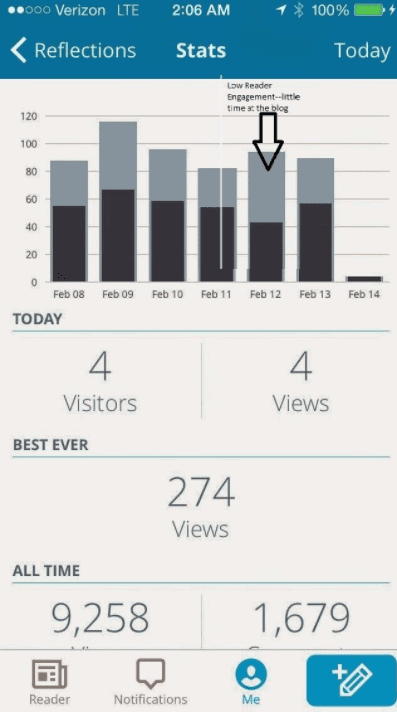
Do you see how I rebranded?
By looking at the top of the screenshot, you see the name of my previous site: Reflections.
My traffic was low since people wouldn’t visit a site called Reflections for blogging tips. “Reflections” sounds like a personal development site.
I rebranded as a blogging tips site.
Now look at my traffic metrics:
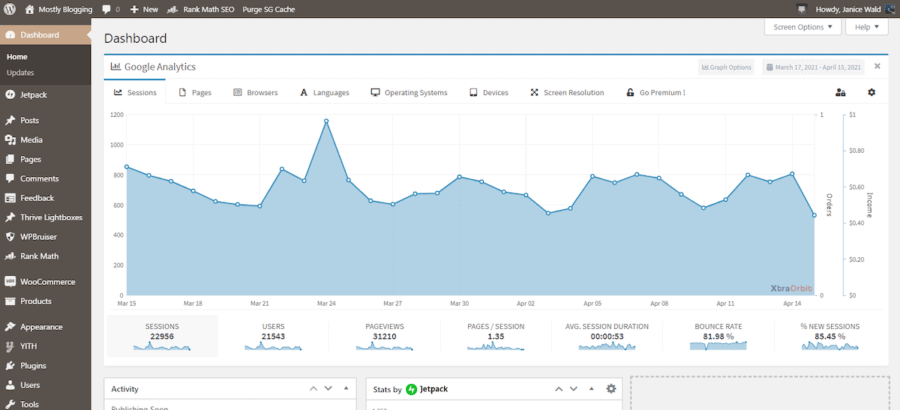
Now, I routinely see metrics like this.
What have we learned about 2021 SEO techniques?
- Update your older content.
- Follow Google’s E-A-T criteria.
- Rebrand.
Please share so other bloggers and content marketers discover these traffic-boosting tips to generate more search engine traffic in 2021.
Author’s Bio: Janice Wald is the founder of MostlyBlogging.com. She is an ebook author, blogger, blogging coach, blogging judge, freelance writer, and speaker. She was nominated as the 2021 and 2019 Best Internet Marketer by the Infinity Blog Awards and in 2017 as the Most Informative Blogger by the London Bloggers Bash. She’s been featured on Small Business Trends, the Huffington Post, and Lifehack. Join us at Mostly Blogging for more social media and writing tips.


